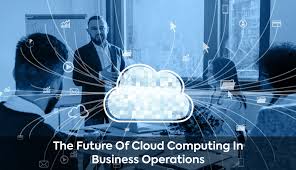Cloud Computing Explained: How It’s Shaping the Future of Business
Cloud computing has revolutionized the way businesses operate by providing scalable, flexible, and cost-effective solutions for managing data and applications. By leveraging the power of the cloud, companies can enhance productivity, foster innovation, and remain competitive in an increasingly digital world. Here’s a comprehensive look at how cloud computing is shaping the future of business.
1. What Is Cloud Computing?
Cloud computing is the delivery of computing services—such as servers, storage, databases, networking, software, and analytics—over the internet (“the cloud”). Instead of owning physical servers or data centers, businesses can access these resources on demand from cloud providers like Amazon Web Services (AWS), Microsoft Azure, or Google Cloud.
2. Key Characteristics of Cloud Computing
- On-Demand Availability: Access resources anytime without physical hardware.
- Scalability: Adjust resources up or down based on current needs.
- Cost Efficiency: Pay only for what you use, reducing capital expenses.
- Global Accessibility: Access data and applications from anywhere in the world.
3. Types of Cloud Computing
- Public Cloud: Services offered over the public internet, shared among multiple users (e.g., AWS, Google Cloud).
- Private Cloud: Dedicated infrastructure for a single organization, offering more control and security.
- Hybrid Cloud: Combines public and private clouds, allowing data and applications to be shared between them.
- Multi-Cloud: Use of multiple cloud services from different providers to meet specific needs.
4. How Cloud Computing Is Transforming Business
a. Enhanced Collaboration
- Teams can access shared files and applications in real time, facilitating seamless collaboration, especially for remote and global teams.
- Cloud-based tools like Microsoft Teams and Google Workspace enable efficient communication and project management.
b. Innovation Acceleration
- Cloud platforms provide tools for AI, machine learning, and big data analysis, enabling businesses to innovate faster.
- Startups and enterprises can rapidly prototype and deploy applications without significant infrastructure investment.
c. Improved Customer Experiences
- Cloud-based CRM systems, like Salesforce, analyze customer data to provide personalized experiences and proactive service.
- Businesses can scale services during peak demand to maintain seamless user experiences.
d. Cost Optimization
- Companies eliminate the need for expensive hardware, energy, and maintenance costs.
- Flexible pricing models, such as pay-as-you-go, allow businesses to align expenses with usage.
e. Business Continuity and Disaster Recovery
- Cloud services provide reliable backups and redundancy, ensuring minimal downtime during disruptions.
- Critical data is stored securely and can be restored quickly in the event of hardware failures or cyberattacks.
f. Global Reach
- With data centers worldwide, cloud providers enable businesses to expand their services globally with minimal latency.
5. Challenges of Cloud Computing
a. Security and Privacy
- Storing sensitive data in the cloud raises concerns about data breaches and unauthorized access.
- Businesses must ensure compliance with regulations like GDPR and HIPAA.
b. Dependency on Internet Connectivity
- Cloud services require stable and reliable internet connections, which may not be available in all locations.
c. Vendor Lock-In
- Migrating from one cloud provider to another can be complex and costly due to proprietary systems and data formats.
d. Cost Management
- While cost-effective, poorly managed cloud usage can lead to unexpected expenses from over-provisioning or unused resources.
6. Emerging Trends in Cloud Computing
a. Edge Computing
- Processes data closer to its source (e.g., IoT devices) to reduce latency and improve performance.
b. AI and Machine Learning Integration
- Cloud platforms are embedding advanced AI tools to automate processes, analyze data, and make predictions.
c. Serverless Computing
- Developers can focus on code while the cloud provider manages infrastructure, enabling faster deployment of applications.
d. Sustainability
- Cloud providers are adopting green technologies and renewable energy to reduce the environmental impact of their data centers.
e. Industry-Specific Clouds
- Tailored cloud solutions for industries like healthcare, finance, and retail meet specialized regulatory and operational needs.
7. The Future of Cloud Computing
Cloud computing is driving the digital transformation of businesses across all sectors. In the future, we can expect:
- Increased adoption of hybrid and multi-cloud strategies for flexibility.
- Greater reliance on AI-driven cloud services for automation.
- Integration with emerging technologies like quantum computing and 5G for unprecedented speed and computational power
Conclusion
Cloud computing is not just a trend; it’s a foundational technology shaping the future of business. By embracing the cloud, organizations can streamline operations, foster innovation, and unlock new growth opportunities. As technology continues to advance, the potential of cloud computing will only expand, making it an indispensable tool for businesses worldwide.
Would you like to explore how cloud computing can benefit a specific industry or application?










Leave a Comment